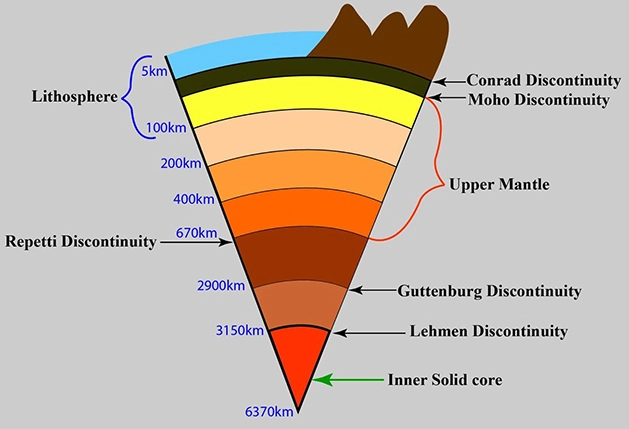Important Facts For Prelims
Core-Mantle Connectivity
- 11 Jun 2025
- 6 min read
Why in News?
A study by German researchers reveals that precious metals like gold, platinum, and ruthenium are leaking from the Earth's core to the surface via volcanic activity, challenging the long-standing belief that the core is geochemically isolated.
What are the Key Insights from Recent Studies on the Interaction Between Earth’s Core and Mantle?
- Core-Mantle Material Exchange: Researchers studied volcanic rocks from Hawaii, created by mantle plumes (hot rock columns) rising from the core-mantle boundary.
- They detected high levels of ruthenium-100 (^100Ru), an isotope mainly found in the Earth’s core, showing that core materials travel upward through mantle plumes.
- This reveals greater connectivity between the core and mantle than earlier assumed.
- They detected high levels of ruthenium-100 (^100Ru), an isotope mainly found in the Earth’s core, showing that core materials travel upward through mantle plumes.
- Precious Metals Locked in Earth’s Core: The Earth’s core contains over 99.999% of the planet’s gold along with other siderophile (iron-loving) elements like platinum, iridium, and ruthenium.
- These metals were traditionally thought to be inaccessible due to a thick rock barrier separating the core from the mantle and crust.
What are the Key Facts About Earth’s Mantle & Core?
- Mantle:
- Structure: The mantle constitutes about 83% of Earth’s volume and 67% of its mass, extending from the Moho discontinuity ( around 7-35 km depth) down to the core-mantle boundary at 2,900 km depth.
- It is primarily composed of silicate rocks rich in iron and magnesium, with elemental composition approximately 45% oxygen, 21% silicon, and 23% magnesium.
- Common silicates found in the mantle include olivine, garnet, and pyroxene.
- It is primarily composed of silicate rocks rich in iron and magnesium, with elemental composition approximately 45% oxygen, 21% silicon, and 23% magnesium.
- Density and State: The upper mantle’s density ranges from 2.9 to 3.3 g/cm³, while the lower mantle’s density varies from 3.3 to 5.7 g/cm³.
- The asthenosphere is a layer of the upper mantle, while the lower mantle extends deeper into the Earth.
- While the asthenosphere is partially molten and can flow, the immense pressure in the lower mantle keeps it in a solid state, despite the high temperatures.
- Temperature Gradient and Convection: Temperatures increase from around 200°C near the crust to nearly 4,000°C at the core-mantle boundary.
- This temperature difference drives mantle convection, where solid silicate rock behaves plastically and circulates slowly.
- This convection is fundamental to the movement of tectonic plates at the surface.
- Seismicity: Despite high-pressure conditions that normally inhibit seismic activity, earthquakes occur in subduction zones down to depths of 670 km, within the mantle.
- Structure: The mantle constitutes about 83% of Earth’s volume and 67% of its mass, extending from the Moho discontinuity ( around 7-35 km depth) down to the core-mantle boundary at 2,900 km depth.
- Earth’s Core:
- Structure: The Earth’s core lies beneath the mantle, starting at about 2,900 km depth and extending to the planet’s center at approximately 6,371 km.
- It is primarily composed of iron and nickel, with some lighter elements.
- Outer Core: Extending from 2,900 km to about 5,150 km depth, the outer core is a molten, liquid layer approximately 2,250 km thick, with temperatures ranging between 4,000°C and 6,000°C.
- The movement of its liquid iron generates Earth’s magnetic field through the geodynamo process. Its density is lower than the inner core due to its liquid state.
- Inner Core: Located from approximately 5,150 km depth to the Earth's center, the inner core is a solid sphere with a radius of about 1,220 km.
- Despite extremely high temperatures ranging from 5,000°C to 7,000°C, it remains solid due to the immense pressure exerted by the overlying layers.
- Composed primarily of an iron-nickel alloy, the inner core is highly dense and plays a critical role in Earth’s internal heat transfer.
- It also influences the planet's magnetic field, although the geodynamo effect (magnetic field generation) is primarily driven by the swirling liquid iron in the outer core.
- The inner core exhibits high thermal and electrical conductivity and rotates eastward slightly faster than the Earth's surface, completing an extra rotation approximately every 1,000 years.
- It is separated from the outer core by a boundary known as the Lehmann Discontinuity.
- Structure: The Earth’s core lies beneath the mantle, starting at about 2,900 km depth and extending to the planet’s center at approximately 6,371 km.
Asthenosphere:
- The asthenosphere is the upper mantle layer from 80 to 200 km depth, located beneath the rigid lithosphere.
- It is ductile, mechanically weak, and highly viscous, with density greater than the crust. These properties facilitate tectonic plate movement and isostatic adjustments.
- It is also the main source of magma for volcanic eruptions.
UPSC Civil Services Examination, Previous Year Question (PYQ)
Prelims
Q. In the structure of planet Earth, below the mantle, the core is mainly made up of which one of the following? (2009)
(a) Aluminium
(b) Chromium
(c) Iron
(d) Silicon
Ans: (c)








